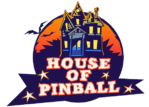There’s something magical about owning a vintage pinball machine—the artwork, the mechanical charm, the nostalgia. But as the demand for classic machines rises, so does the risk of buying counterfeit or misrepresented models.
Whether you’re a first-time collector or a seasoned buyer, knowing how to authenticate a vintage pinball machine can save you thousands and ensure you’re investing in the real deal.
At House of Pinball, we’ve helped collectors across Canada find genuine pinball machines for sale—and avoid costly mistakes. In this guide, we’ll break down how to spot authentic machines, what red flags to watch for, and where to safely buy your next vintage pinball.
🎯 Why Authentication Matters
Authentic vintage pinball machines:
- Hold or increase their value over time
- Have collector credibility
- Are often higher quality and more durable
- Provide the true nostalgia experience
Fakes or “frankensteined” machines (those pieced together from mismatched parts) can look convincing but may:
- Break down easily
- Have incorrect or missing parts
- Be overpriced for what they are
- Lack resale value
✅ Step 1: Check the Manufacturer Plate and Serial Number
Every authentic pinball machine has a manufacturer plate—typically located:
- On the inside of the cabinet near the coin door
- On the back or underside of the cabinet
- On the backbox frame
Look for:
- Brand name: Bally, Williams, Gottlieb, Stern, etc.
- Serial number: A unique ID tied to the production batch
- Model number: To match against known databases
💡 Tip: Use resources like IPDB.org (Internet Pinball Database) to verify the machine’s details using the serial number and title.
✅ Step 2: Inspect the Artwork and Cabinet Details
Fakes often miss the mark when it comes to artwork. Here’s what to examine:
🔍 Key areas to inspect:
- Cabinet stenciling or decals: Should match the original color scheme and style
- Backglass art: Should be vibrant and true to era (not reprinted or pixelated)
- Playfield design: Should match original layout and colors
🛑 Red flags:
- Mismatched themes (e.g., artwork from one game but a playfield from another)
- Poor-quality reproduction decals or overlays
- Cabinet repaints that hide damage
✅ Step 3: Examine the Internal Components
Open the machine and take a look inside.
What to check:
- Boards & wiring: Should be clean and match the machine’s make/year
- Flippers & solenoids: Should be era-appropriate and properly mounted
- Labels & stamps: Look for original part numbers, stickers, or chalk marks
💡 Pro Tip: Take photos of the internals and compare them to verified machines online.
✅ Step 4: Compare Against Known Specs
Use trusted sources like:
- Internet Pinball Database (IPDB.org)
- Pinside.com forums
- Manufacturer archives and catalogs
Cross-reference:
- Playfield layout
- Scoring system (mechanical vs. digital)
- Number of flippers, bumpers, ramps
- Audio system (chimes vs. speakers)
If something doesn’t match the official version, it may be altered or misrepresented.
✅ Step 5: Ask for a Full Ownership History
Any reputable seller should be able to tell you:
- Where they got the machine
- How long they’ve had it
- What repairs or modifications were done
- If it has original or reproduction parts
If they can’t answer basic questions, be cautious.
✅ At House of Pinball, every vintage machine comes with a detailed service history, so you know exactly what you’re getting.
✅ Step 6: Get a Second Opinion or Inspection
If you’re unsure, hire a pinball technician or collector to inspect the machine—or ask the seller to provide a video walkthrough of the machine powered on and working.
You’re spending real money—don’t skip this step.
✅ Step 7: Only Buy from Trusted Sources
Avoid:
- Sketchy online listings with vague details
- “Too good to be true” prices
- Sellers who refuse video demos or history info
Buy from:
- Reputable pinball retailers (like House of Pinball)
- Collectors with solid community reputations
- Verified arcade or museum auctions
🛡️ House of Pinball guarantees authenticity on all vintage and refurbished machines. No guesswork, no fakes—just verified classics.
👉 Explore Authentic Vintage Pinball Machines for Sale
⚠️ Warning Signs of a Fake or Frankensteined Machine
| 🚩 Red Flag | ❌ What It Might Mean |
|---|---|
| No serial number | Reproduction or altered unit |
| Different backglass art than model | Part-swapping |
| Modern boards in a 70s machine | Heavily modified machine |
| Mismatched flippers or buttons | Pieced together parts |
| Loose wiring or poor soldering | Amateur repairs |
If you’re seeing more than one of these—walk away.
🧠 Final Thoughts: Knowledge Is Your Best Protection
Authenticating a vintage pinball machine is about details, history, and trust. The more informed you are, the more likely you’ll end up with a true collectible that brings joy—not frustration.
At House of Pinball, we take pride in providing:
- Fully vetted vintage machines
- Transparent documentation and history
- Honest pricing
- Lifetime support for all buyers
🛒 Ready to Buy a Verified Vintage Pinball Machine?
Explore our collection of authentic pinball machines for sale or contact us for expert guidance on your next classic machine.

